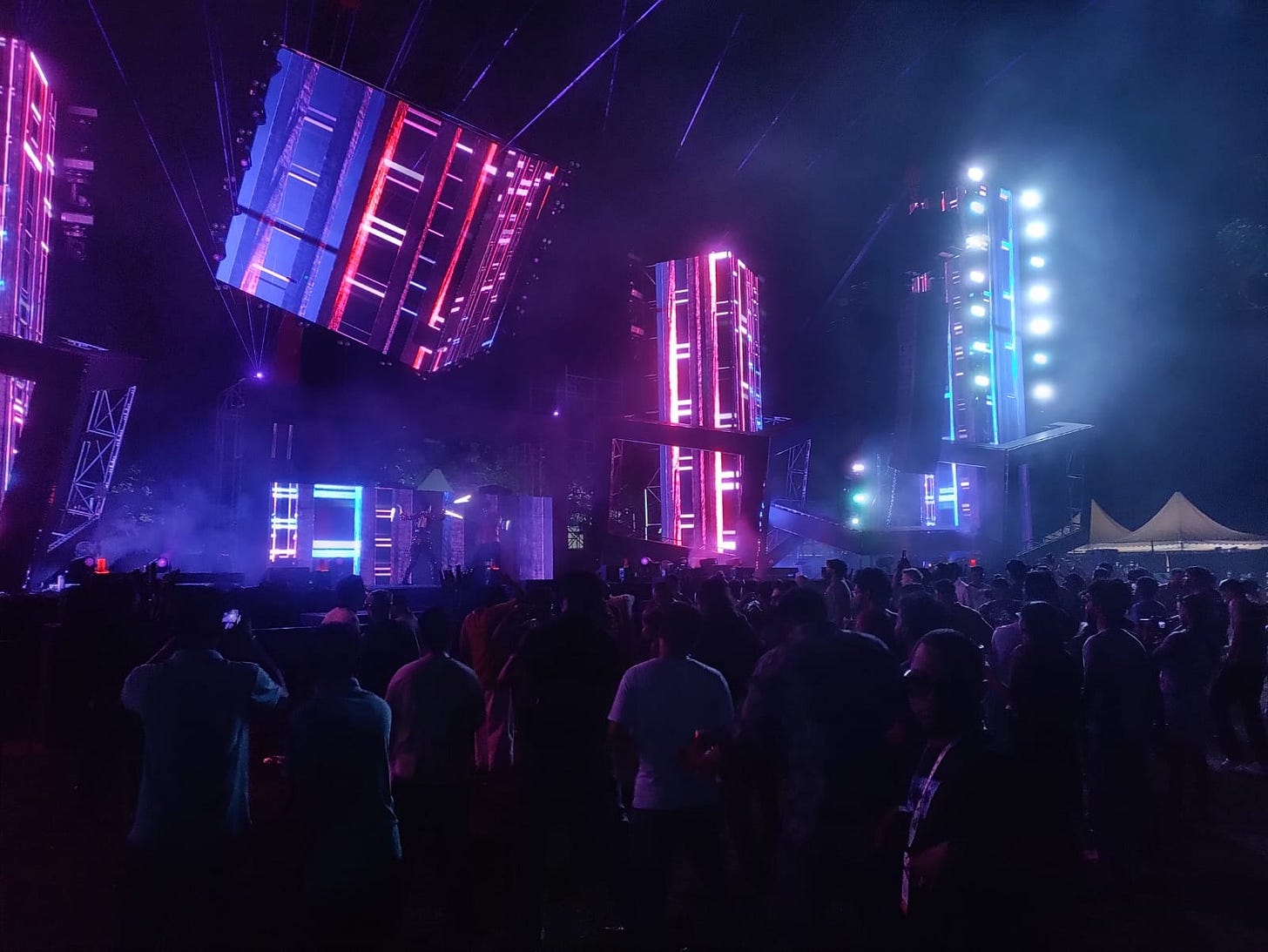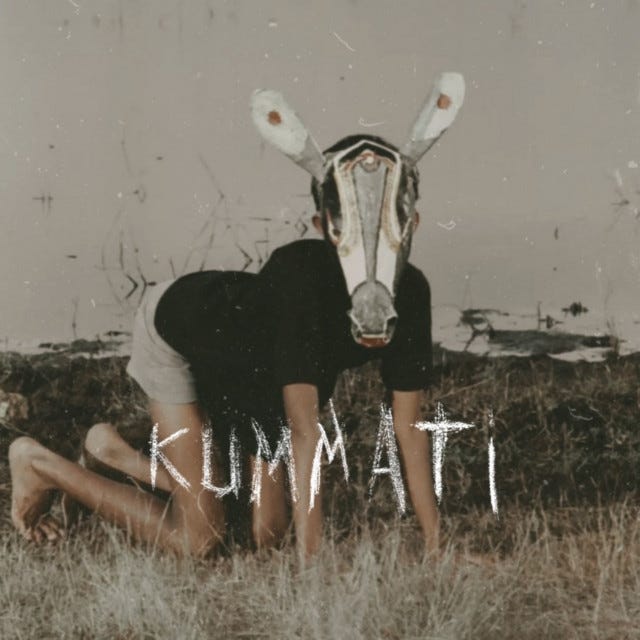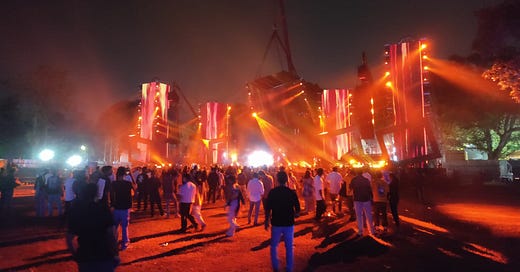Kochi Coming of Age: A young city stands at a cultural crossroads
Will Kochi lose itself in a globalising world or find its place in it?
It’s been six weeks since my last hard night out in Kochi. Six weeks since the deadly cocktail of cheap alcohol, tar-laced tobacco and an overly enthusiastic smoke machine conveniently inflamed my sinus. And six weeks since my friends and I found ourselves relieved to have “left the scene at the right time”. This isn't the first time we’ve felt this way. In fact, we’ve found ourselves frequently possessed by boomer spirits contorting our vocal cords and forcing us to say, “the city’s changed”, only with undertones of cautious excitement rather than judgement.
2025 Kochi is unrecognisable to what was once a pub-less small town. Don’t get me wrong. We’ve always had bars. But ‘pubs’ were different. ‘Pubs’ were what people in Bangalore went to. It served a younger, co-ed crowd instead of uncles who had perfected the art of hastily downing a drink before returning to their families. Pubs had live music. Bars played 9XM. Clutching a handful of 24x7 cafes and big-city dreams, the 2012 Kochi we were once teenagers in didn’t have the weekend plans that big-sibling metros Bombay and Bangalore had. While a Dunkin’ Donuts or a Krispy Kreme was just another corner café for them, we wore our Sunday bests to the first McDonald’s that graced our state in 2013.
But, unbeknownst to our innocent, unexposed selves, our own big brothers and some lucky sisters had their spots; subterranean scenes that were so underground that we only knew of their existence in whispers. However, as we marched into 2010, those whispers quickly turned into melodic shouts and heart racing roars, loud enough to reverberate across Kerala and beyond, as Kerala folk rock, fusion rock and folk metal announced the arrival of an original sound. Desperate pleas to older cousins were answered with mp3 tracks of The Down Troddence while Motherjane and Avial gave crash courses on their genres in their canonical Rosebowl appearances. As more bands came out of the woodwork and audiences openly began to proclaim their allegiance to them, the new cultural phenomenon culminated at the iconic Mojo Rising 2015 — Kappa TV’s 14-hour non-stop music fest.
We’ll never forget that first edition of Mojo Rising. Kochi’s Bolgatty Palace grounds where we previously used to have family picnics was now littered with metalheads and rock fans, brandishing their horned fists in the air, proudly celebrating their subculture as it waded into the mainstream for all of us to see. And man, the sights we saw…Black Letters hitting each note as hard as the afternoon sun. Ameeth Thomas stuffing his lit cigarette between his guitar’s nut before rocking out with the rest of Junkyard Groove. And peak Thaikkudam Bridge who played unreleased tracks from their then upcoming debut album, Navarasam. It was then that we truly understood the pride with which our dads and uncles remembered the Kochi of their time that witnessed 13AD and Osibisa live. We realised that this concert was one of those moments in our city’s history that would be embedded in its cultural consciousness. The clandestine culture of our time had finally come to the light and the city had embraced it.
My generation was lucky to grow up with this Kochi. We were adolescents when Kochi was a small town and young adults when that small town grew into a young city. And right now, this young city that we’ve always called ‘home’ is at another fascinating cultural crossroads.
Since that fateful day in 2015 when Mojo Rising popularised the Kerala sound, Kochi’s music scene has taken the form of a metric to measure how quickly the city is adopting national and global culture. Around the world, electronic music and its army of subgenres have been playing on loop since the ‘90s, but techno’s meteoric rise to popularity has been fairly recent, climbing steadfastly without a drop in sight. Kochi’s picked up this change in frequency and it did so at exactly the right time — as tourism booms across the state.
With the State Government loosening many restrictions to adopt new tourism initiatives, Kerala has emerged as a popular destination for travellers around the country and beyond; especially artists for whom it is now a pilgrimage site thanks to the Kochi-Muziris Biennale. The Biennale is arguably one of the most significant players responsible for granting the state a permanent residence on the international cultural map. With entry tickets at ₹50 during the first edition in 2012, the festival recorded an average of thousand visitors a day, reaching ten thousand on weekends. Everyone from your next-door neighbour to a Moscow-based art curator could be found wandering the streets of Fort Kochi, where business went up by 80% as per the record of the manager at Kochi’s iconic Hotel Seagull. By its second edition, the Kochi Biennale foundation had received a total of ₹12 crores through private donations, crowd-funding campaigns and State allocations, which became the highest sum a state government in India has ever given to an art event.
While art and culture tourism significantly picked up during these years, post-pandemic travel took things to a whole new level. In the world’s desperation to start travelling again, Kerala had become a first-choice destination among global tourists. With a 21% increase from pre-pandemic levels, the state’s tourism industry exploded at a record 2.22 crore visitors in 2024. While an increasing number of domestic travellers hopped, skipped and jumped on over, the growth rate for international tourists visiting the state had become higher than the national average. To host our gracious economy-boosting guests, the State government worked the tourism department overtime, introducing heli-tourism and seaplane services, e-visa facilities and immersive local stays while optimising inter-city travel with the Kochi Water Metro network.
Within districts, cafes and event spaces are multiplying, aggressively hosting open mics, workshops and live gigs. Kochi’s flourishing food scene has emerged as the perfect hype man to lift up the city’s music scene. This is owed partly to the State limiting bar licenses to three-star hotels and above. While this seemed to jeopardise tourism, the move has instead prompted the city’s hospitality industry to embrace resto bars. As more eateries leave their stoves on into the night and more pubs leave their lights on for a little longer, opportunities increase for music to occupy these spaces. Bustling crowds regularly flock to Fort Kochi’s Francis to attend musician Ayesha John’s cover sets, while enjoying a late-night beer in the tavern-like pub. Nikhil Velayudan is a regular act at Rocks and Brews whose new outlet at Hotel Benhur has taken the city by storm.
Curfews proposed by the government to dodge a rising drug menace have even been met with vehement public backlash, especially from the city’s youth and local businesses to whom nightlife provides a promise of good times and prosperity. Unable to deny the successes of a thriving nightlife, the State has liberalised its excise policy, leading to a titanic 2,662% increase in pubs and bars over the last eight years. Plans are also underway to use public premises as venues for buskers and bands to perform for free. As weekend scenes increasingly get sorted, the battle for nightlife in Kochi is witnessing fewer casualties and more victors.
Unsurprisingly, Kochi’s city status is a byproduct of this rapid globalisation fuelled by a tourism boom. But added to that mixture is the state’s staggering 98.1% student digital literacy rate — the highest in the country. With the window to the world in their hands, Kerala’s youth consumes globalised cultural forms and templates before their morning breakfast. Everyone’s online and we’re all busy studying algorithms to trend and thrive in a free market of cultural capital. As more streamers, vloggers and content creators emerge, many adopt tried-and-tested templates that increase their chance to achieve internet virality.
At this juncture, a familiar name emerges once again, albeit in a new guise. Kappa, now evolved from a TV channel to a full-fledged production house and music label, is once again at the forefront of guiding the city towards the dominant electronic and hip-hop music culture of the time. Aptly named, their CULTR festival has caught the attention of ravers around the country and the world, with acts like Miss Monique headlining the first edition in 2024 and an exclusively electronic line-up taking over the two stages in the second edition earlier this year.

There’s no doubt that CULTR is solidifying Kochi’s spot on the map with its high-end festival infrastructure, equal-parts professional and equal-parts chill management and dazzling line-up. It follows a template of any other contemporary music fest, so its success is a natural consequence.
But therein lies the very cause for concern.
Standing at the very same Bolgatty Palace grounds, only this time for CULTR 2025, I realised I could very well have been standing in festival grounds somewhere in Bangalore, Bombay or any other city that had the potential to host an event of such a scale. Like any commercial behemoth, it administered the right dopamine doses through cool sponsors, reputed food stalls and a glamorous crowd. Every ingredient was laced with quality and style that drove sales and publicity, establishing Kochi as a new venue in the world of music festivals. So, celebrities and state government representatives understandably extended their support for it.
But in the rush to become a fest of international standards, there was nothing Kochi or Kerala about it. And was it a space for “everyone” like how the fest and its patrons claimed? That question would better be answered by the horde of Kochi’s youth who stood outside the festival gates, asking attendees if they could borrow their high-priced wristbands to catch a glimpse of what was happening in their city. With the lack of homegrown talent in the line-up despite Kerala’s rising electronic music scene, the bigger questions arise — What kind of culture is truly being celebrated here and who is allowed to be a part of it? While CULTR was like every other enjoyable fest fine-tuned to fit a certain standard of exclusivity and globally accepted quality, it seemed to lack an authentic form of what its name promised.
As Kochi becomes more globalised and experiments with more festivals, gigs and live events, the possibility exists for the city, in its haste to reach Tier 1 status, to clumsily fall into a void of indiscernible cultural homogeneity. But there also exists another possibility for this young city and its inhabitants — the exciting chance to redefine their cultural identity for the new era they enter, so that while Kochi and Kerala meet the rest of the world, the rest of the world knows exactly who they are rubbing shoulders with.
In the growing electronic music landscape, the Kerala sound has once again reincarnated through the music of electronic/techno artists like 6091 and Shanka Tribe. Rooted to his own experiences and influences, Trivandrum-hailing 6091’s music holds “story, character, emotion, and culture” — ingredients that form a personality from which emerges an original style. Shanka Tribe on the other hand, experiments with tribal and indigenous instruments from around the world, consciously using their sounds to translate it into homegrown, organic trance music. While both artists maintain distinct musical identities within their genre, their sounds carry the same nostalgia that connects them and their listeners to a shared cultural history that is re-introduced through globally recognised formats.

This balance between global influence and cultural individuality can also be found in certain pockets of Kochi, where the global cultural exchange of music has led to the creation of distinct city spaces.
Last December, I found myself walking towards a psy-trance rave tucked away between lanes near Vytilla Mobility Hub — Kochi’s major intercity bus terminal; the last place you’d expect to witness anything remotely psychedelic or trancelike. We alighted from our auto and like the beginning of most scenes, followed the low, thumping rhythm to Space. — a venue we’d never been to before and one unlike anything we’ve ever seen. We turn a corner to an open-ground parking lot lit up with just enough yellow lights. The gates are open and people are freely walking in and out while a DJ plays his set in a corner, on an unintentionally brutalist stage made out of corrugated metal sheets, wooden planks and cable reels. Opposite to that was their cafe — a beautiful hut made entirely out of window frames that served momos, nuggets, Boost and other comforting post-party foods. Here, attendees lounged on cane chairs made by a local artisan who had used the venue to conduct a workshop on traditional carpentry. From aunties and uncles rocking everyday churidars and mundu to dapo-star obsessed psy-trance ravers, Space. was open to all. With no entry fee that night and an infrastructure that not only wowed but welcomed, the venue is one among Kochi’s finest platforms where a culture of artistic expression and cultural exchange between artists and audience is encouraged.
JD’s Jukebox in Kaloor is another example. The record store set up at the owner’s childhood home is Kochi’s sonic Shangri-La where people come together, put on their favourite record and simply vibe to the music and eventual conversations that unfold through it. Within walls painted by friends and visitors rests more than 6,000 records which have travelled across countries and generations to reach the humble Kaloor abode. With corners dedicated to patrons who have donated music books, record collections and cassettes, JD’s is a tapestry of all who have entered the space and made it their own. Sujit, the owner, embodies the philosophy upon which the space is built — to “live and let live with music”, inviting everyone to occupy the space as their own hangout spot with no pressure to make any purchase.

Such spaces, artists and individuals embody a DIY spirit that is motivated by creativity and curiosity over commercial glamour. With an open invitation to all, these stalwarts are creating something that is unique to their history and hometown; just intimate, inviting and interesting enough without trying too hard to be. Through the things they create, we know their story starts here, rooted and ready to explore the world beyond their own. They follow no template, resemble no references and desire for nothing more than to create a scene of their own in their city.
One could say that Kochi is currently going through its contemporary-era young adult phase — ultra-exposed and vulnerable to all kinds of influences. The city walks the path of discovering its own identity while growing alongside a rapidly changing and intermingling global environment. As it comes of age, it is poised to enter its new cultural era, with a full realisation of who it is and what it has to offer to the rest of the world.








This piece evoked so many emotions. Beautifully captured, thank you.
Gonna give JD’s jukebox a visit cuz that is everything I WISHED FORRRRRR!!!!!